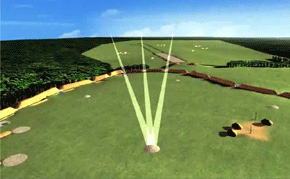FORT ANCIENT
THE FOURSQUARE
Four low, limestone-covered mounds form a perfect square inside the North Fort, 512 feet on each side. Look for one near the ticket booth, one across Route 350, another south of the North Gate, and a fourth near the Museum’s parking lot. Their original limestone coverings had been heavily burned: it was oxidized, red, and crumbly; and the fossils in it had turned white. Huge fires had been set atop these stone-surfaced mounds, obviously for some dramatic, ritual purpose. This perfectly-defined, fire-demarcated square space seems to have been kept absolutely clean and free of buildings, suggesting it was sacred.
Trees would have been cleared to allow clear views from the western stone mound to the three, key astronomical alignments, through the gateways and out to the northeastern horizon. Today, the solstice gateway opening (just north of the highway) is kept clear, to allow for a special sunrise celebration held here every June 21. Site archaeologist Jack Blosser talks about Native participation in solar calendar events:
We’ve had some people of Native descent come to the grounds, and they perform their own specific ceremony they’ve been taught through their traditions. One year we had a winter solstice, and we had an elder with two helpers: the sun was obviously not going to come out, and he said, “Be quiet and listen.” He proceeded to get his equipment out. The helpers twisted the leather between their staffs and the elder had another staff and at the right time he began his prayers. And you knew it was the right time, because if you looked, you could see a very light shadow from the staff to the leather.

From the western stone mound, gateway alignments mark the summer solstice sunrise, and the minimum and maximum northern moonrises.


